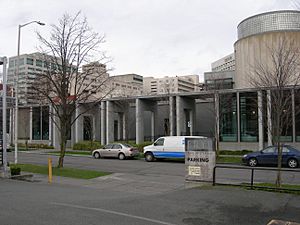Frye Art Museum facts for kids

The Frye Art Museum (2007)
|
|
| Established | 1952 |
|---|---|
| Location | 704 Terry Avenue Seattle, WA 98104 (United States) |
| Type | Art |
| Collections | Modern and Contemporary art |
| Founder | Charles and Emma Frye |
| Architect | Paul Thiry (1952) original; Rick Sundberg of Olson Sundberg Kundig Allen Architects – (1997) remodel |
| Public transit access | LINK light rail Pioneer Square station |
The Frye Art Museum is an art museum in Seattle, Washington. It shows both modern and contemporary art. Charles and Emma Frye started the museum in 1952 to share their art collection. Today, it also features new art shows by different artists.
Contents
History of the Museum
The museum mainly focuses on paintings and sculptures from the 1800s until now. It all started with the private art collection of Charles H. Frye (who lived from 1858 to 1940) and Emma Lamp Frye (who passed away in 1934). The Fryes were Americans whose families came from Germany. They mostly collected German and Austrian art. They often bought these artworks directly from artists' studios in Munich.
Charles Frye owned a meatpacking plant in Seattle. In his will, he set aside money to build a museum for the Fryes' collection of 232 paintings. The Fryes first offered their collection to the Seattle Art Museum. However, that museum said no. This was because Charles Frye's will had special rules. These rules said the art must always be on display. It also had to be shown in natural light. The will also stated that the art could not be shown with abstract work. And, importantly, admission to see the art had to be free.
After Charles and Emma Frye had both passed away, their home was sold in 1941. Many of their paintings were then moved to the meat plant. Walser Greathouse looked after the art. The stored artwork survived a big fire at the plant on February 18, 1943. This fire happened after a B-29 bomber prototype crashed. This bomber was a top-secret military project at the time.
The Frye Art Museum was built in Seattle's First Hill neighborhood. It opened to the public in 1952 as a free art museum.
Art Collection Changes
The Fryes' original collection had representational art works. These artworks often showed dark, dramatic, or psychological themes. The museum's permanent collection still shows Charles Frye's traditional art tastes. At first, the museum only bought and showed representational art. This traditional approach matched the views of its first director, Walser Greathouse (who passed away in 1966). His wife, Ida Kay Greathouse, took over and ran the museum until 1993.
After 2007, the art shown and collected by the museum began to change. It started to include more modern art forms, like Conceptual Art. This was different from the rules Charles Frye had set in his will. Because of these changes, some people compared the Frye Art Museum to Seattle's Henry Art Gallery.
Museum Building Design
The original building for the Frye Art Museum was designed by architect Paul Thiry. In the mid-1990s, the museum was made bigger and updated. Architect Rick Sundberg, from Olson Sundberg Kundig Allen Architects, led this renovation. As part of the updates, the museum added a 142-seat auditorium. It also added a studio for art education.
Exhibitions and Programs
The museum has hosted many interesting exhibitions. One show, "Subspontaneous: Francesca Lohmann and Rob Rhee," featured sculptures. These sculptures explored natural forces and how things grow in nature. Other exhibitions included "Agnieszka Polska: Love Bite" and "Unsettling Femininity: Selections from the Frye Art Museum Collection." The museum often rearranges its permanent collection. This allows them to try out different ways of showing the art. In 2018, the museum had 109,249 visitors. It also had 2,383 members.
Many contemporary artists and groups have shown their work at The Frye. These include the performance group Degenerate Art Ensemble. Also, First Nations artist Duane Linklater, American painter Christina Quarles, and African-American filmmaker Cauleen Smith have been featured.
In 2020, during the COVID-19 pandemic, the museum temporarily closed for in-person visits. To keep art available, they offered online art viewing and learning through their "Frye From Home" program. The museum reopened for in-person visits in October 2020.
Art Collection
The Frye Art Museum's collection features many types of paintings, prints, works on paper, and sculptures. Some of the artists whose works are in the museum's collection include Eugène Boudin, Nicolai Fechin, William-Adolphe Bouguereau, Félix Ziem, Eugène Isabey, Franz von Lenbach, Tim Lowly, Fritz von Uhde (who painted Picture Book), Hermann Corrodi (who painted Venice), Ludwig von Zumbusch, Leopold Schmutzler, and Franz Stuck (who painted Judgment of Paris).
Library
The Frye Art Museum library holds more than 2,000 books. It specializes in art from the 19th and 20th centuries, especially American and German art.

